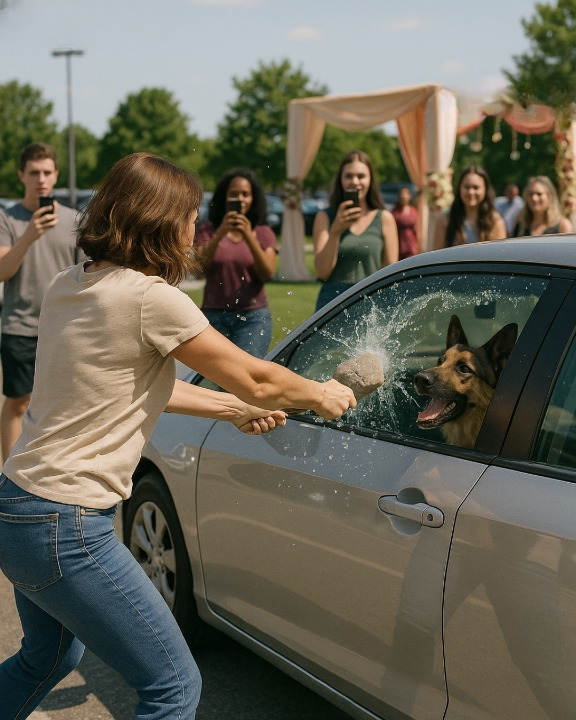It was one of those intense summer afternoons in Copperfield Springs, Arizona, when the sun seems to press down from every angle, and the air feels heavy with heat. I had only planned a short trip to the market—just a few essentials: pasta, sauce, and perhaps a fresh loaf of bread. The thought of takeout felt unappealing, and the idea of cooking in the sweltering heat seemed unbearable, but necessity won.
As I stepped out of my air-conditioned car, the dry, heavy air immediately hit me. The parking lot was nearly empty, with most people wisely avoiding the outdoors. That’s when I noticed something unusual. A silver hatchback parked a few rows over had a dog inside. At first glance, it seemed calm, but a closer look revealed that the Border Collie mix was lying in the backseat, breathing quickly and with her tongue out, unable to reach the bottle of water in the passenger seat. The windows were rolled up, and the sun’s heat made the interior feel like an oven.
A note under the windshield wiper indicated the owner would be “back soon” and that the dog had water. Concerned, I called the number provided. A man answered, his tone impatient. I explained that the dog appeared to be in distress and needed immediate attention. He responded that she was fine and asked me not to interfere.
The conversation left me uneasy. The dog could not access the water, and every minute in that heat increased the risk. Observing the dog’s condition and the stillness of the parking lot, I knew action was needed. I scanned the area and found a large landscaping rock nearby. With careful effort, I broke the rear side window and reached in to unlock the door.
The dog collapsed onto the pavement as I gently lifted her out. I offered her some water and shaded her from the sun. Soon, passersby began assisting—someone brought a towel, another called local authorities. Within minutes, animal control and police arrived to assess the situation. They checked the dog thoroughly and confirmed that prompt intervention had likely prevented serious harm.
The owner arrived moments later, upset about the broken window. Police and animal control explained the circumstances and confirmed that the dog had been at risk. The officials advised that the situation was handled appropriately and that no further action would be taken against me. The dog was then taken into temporary care to ensure her full recovery.
That night, she rested comfortably in my home with fresh water, food, and a safe space to recover. Since I did not know her original name, I decided to call her Sierra. Over the following weeks, as the legal process concluded, her previous owner relinquished custody, and I officially adopted her.
Sierra quickly became an inseparable companion. She follows me around the house, naps beside my desk, and loves walks and car rides with the windows down. Her transformation from a stressed, overheated animal to a lively, affectionate companion was remarkable. Her presence reminded me of the importance of vigilance, empathy, and timely action.
Reflecting on that day, I realized that quick decisions based on concern for another living being can make an extraordinary difference. While some might describe my actions as bold, they were driven by a simple principle: people can replace objects, but lives are irreplaceable.
Sierra’s story also served as a reminder to the broader community about the significance of animal safety, especially in extreme weather conditions. She became a small local symbol of awareness, prompting friends and neighbors to check on pets in similar circumstances. Many shared their own stories of helping animals, creating a ripple effect of care and attentiveness.
Beyond the immediate rescue, the experience fostered a deeper connection between Sierra and me. Her trust was evident in every interaction: a wagging tail, a gentle nudge, or the way she eagerly joins me for walks around the neighborhood. She quickly adapted to her new home, bringing warmth and joy into daily life.
Even months later, the memory of that afternoon remains vivid—the heat, the still parking lot, the urgency, and the eventual relief of seeing Sierra safe and comfortable. It is a story about action, compassion, and the unexpected ways our everyday routines can change lives.
Now, each time I see her resting peacefully or happily exploring the outdoors, I am reminded that simple acts of attention and care can have a lasting impact. That day, what began as a routine grocery trip became an unforgettable experience, one that changed both our lives in profound ways.
In the end, the lesson is clear: awareness and timely intervention can protect those who cannot advocate for themselves. Sierra is a daily reminder of that truth, a living example of how empathy, courage, and a willingness to act can create life-changing outcomes.
